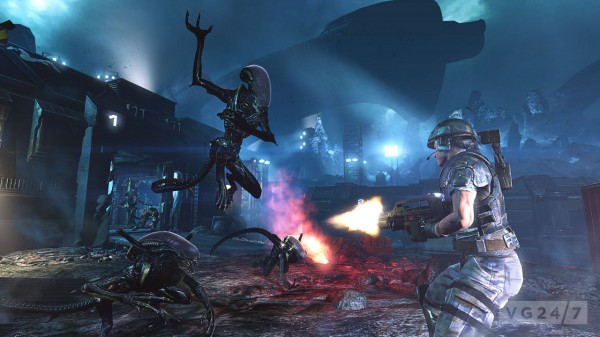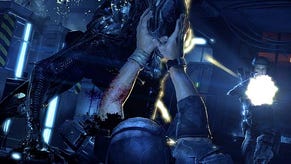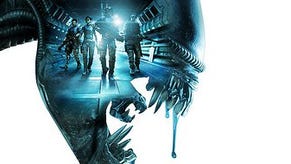Aliens Colonial Marines: assholes and elbows
Aliens: Colonial Marines is the canonical sequel to James Cameron's 1986 movie. VG247's Dave Cook goes hands-on and speaks with Gearbox Software about its development.
It's little wonder that critics and fans have compared James Cameron's searingly brilliant Aliens to the Vietnamese war. The film showed a group of brash, cocksure marines talking trash and entering into a conflict they didn't fully understand, armed with bad language, testosterone - and as Hudson so colourfully put it in the film - 'Nukes, knives, and sharp sticks'.
Within moments, the group finds themselves ambushed by Xenomorphs in the creaking confines of Hadley's Hope, a sprawling, claustrophobic space colony on LV-426. Panic and confusion sets in, reducing the swaggering band of jarheads to gibbering children without a plan, and completely without hope.
At one point in Aliens, the marines' predicament is underlined when they find out they have to wait 17 weeks before back up arrives, and realising they're in a hopeless situation, they decide to escape on their own. If you've seen the film you already know how badly that turns out.
Aliens: Colonial Marines tells the story of that back up crew, and the shocking discoveries they find once they make their way into the depths of Hadley's Hope in search of answers. There are nods to the film everywhere, and fans will appreciate the authenticity at hand.
But how do you create that 'Vietnam movie' atmosphere in a game? There has to be tension, a feeling of being outsmarted and overpowered, and the fear that comes with fighting an enemy that can strike from the shadows at any time.
After going hands-on with the game's multiplayer and campaign, it's clear that Gearbox has used its development time well, and has nailed the film's atmosphere perfectly. From the rasping sound of your marine's pulse rifle, to the spine-chilling screech of your motion scanner, everything here feels expertly placed.
“What do you mean, ‘They cut the power’?”
Diving into campaign first, our initial slice of gameplay sees us jumping into the boots of Cpl. Christopher Winter, part of the marine back-up crew. Winter is the star when playing solo, although the entire campaign can be played in co-op with up to four marines and as such, the Left 4 Dead parallels are hard to ignore.
What's interesting is that there is scope here to funnel players into roles. For example, as the squad first make their entrance into Hadley's Hope, everyone's motion scanners start picking up movement, and you have to zero in on the signal to identify it.
Similar to Doom 3 - in which players could only have their torch or a gun out at any one time - using the scanner forces you to holster your weapon. So a smart co-op squad might assign scanning duties to one player and smart gun operation to another, while the other two watch the flanks and rear with pulse rifles or shotguns.
“If there's a whole bunch of Xenos in the room and you just happen to start shooting one, don't kill it, then move on to the one next to it – the one you shot first isn't going to keep running at you. That's because it doesn't want to die. They're smart creatures”
It's not long before you can put those strategies to the test, as the squad finds itself holed up in the same operations bay that the movie team used to discuss their escape plan. Scanners go ape-s**t, and just like in the film it looks as if the aliens are already inside the room with you. But you can't see them.
This really is tense, as you start looking around in a blind panic at all the dots swarming in on your location. Suddenly they start pouring out of the ceiling grates, through the floor and slithering out of air vents, followed by blind chaos.
Auto-turrets can be placed to thin our the pack, but Gearbox's AI is smart. For example, if you simply wound an alien, it will back off and crawl through the nearest exit before regaining health and flanking you from the sides, above, or below. As such you have to make every shot count, or else you'll find yourself ambushed repeatedly.
I asked senior producer Brian Burleson if both the AI and level design proved challenging to code, given the complex, twisted nature of the Hadley's Hope colony, "Levels weren't easy to make in this game, because there are so many cool things we can do.
"The AI is smart because it does have a concept of when aliens have died, and a concept of where they are at – the damage, what routes they can use to get away from you – and if there's no way to escape they can become more aggressive and just tear at you. Because they know they're going to die, they're not going to give up.
“There’s a lot of things that have decayed, things that happened, and that adds a lot of nods for people who have seen the films, and who really appreciate that sort of thing.”
“That makes them very terrifying. Because if there's a whole bunch of Xenos in the room and you just happen to start shooting one, don't kill it, then move on to the one next to it – the one you shot first isn't going to keep running at you. That's because it doesn't want to die. They're smart creatures.
“It really depends on the environment, because if the Xenos know there's an alternate route to get to you, then they'll use it. If there's no alternate route – and this is part of the strategy – you can actually find choke points where the Xenos have to come through.
“But sometimes they Xenos know better and they just hang back, waiting for you to come out or they reposition and go into the vents, or under the ground. They then stalk the player for a better opportunity to come out.”
This happens a lot, and it doesn't help that - after the stand-off in operations - Winter's commanding officer sends him and a buddy off to search for two marines who have gone missing.
The action is then bookended by a still quiet as the pair search the slimy, terraformed hallways to find dead colonists and marines strung up with gaping holes in their chests. The ups and downs of the game's atmosphere are paced well, and keep you on edge at all times, a feeling that all good Aliens games should deliver.
“That’s inside the room.”
Much of the game's authenticity stems from extensive research by Gearbox Software, as well as close collaboration with the film's designer Syd Mead, and studio Fox. The attention to detail is hard to ignore, with collectibles - such as Hicks' shotgun and marine dogtags - littered around recognisable areas.
“Chronologically we come after Aliens and Alien 3," Burleson continued, "about 17 weeks after Aliens. But in the universe the films are history at this point, so there's a lot of neat things to recognise and nod to. When you go through those environments, those things happened.
“The atmosphere processor blew up, there as clearly a fight in operations, Ripley – when she was in that room with Newt – that all exists in the areas that you go through. We recreated those spaces as if they happened in the past.
“Going into those spaces again was really easy to do in collaboration with FOX as we respected it so much, but a lot of times they deferred like, ‘Oh, Syd Mead designed the concept for the Sulaco. That’s official because he did it.’ That makes sense.”
“There's a lot of things that have decayed, things that happened, and that adds a lot of nods for people who have seen the films, and who really appreciate that sort of thing."
While the tone is spot-on, the gameplay is ideal, with slick gunplay and satisfyingly chunky weapons. The Pulse Rifle is of course, an absolutely joy to use and hear, while the smart gun - which uses a scoped night vision reticle that automatically homes in on nearby targets - makes you feel like a god until it runs dry and you come back down to earth.
On Gearbox's collaboration with Fox, Burleson continued, "They've been great to work with because respect for the history is very important. Being canonical, we can't just change things that happened. Like I said before, the atmosphere processor blew up. That existed, and one thing they were keen on preserving was that historical events happened.
“There are some areas the film didn't go into too deeply, or that were more ambiguous, so there is some room to explore when going back to those environments. Just like on the Sulaco – in the film you only saw the locker room, the training area, the mess hall and the dropship hanger.
“There's so much more of that ship, it's a giant ship. Going back and creating things you didn't see, filling in those gaps, and working with people like Syd Mead who did the original designs, that made it very authentic.
“Going into those spaces again was really easy to do in collaboration with FOX as we respected it so much, but a lot of times they deferred like, 'Oh, Syd Mead designed the concept for the Sulaco. That's official because he did it.' That makes sense."
While it was a fleeting hands-on session, Aliens: Colonial Marines hits all the right spots. It'll be interesting to see how all of Gearbox's new area and alien types feel when compared to the elements of the film we already know. Up next: multiplayer.
“Marines! We are leaving!”
This is where things really get fun. Comparable again to Left 4 Dead, Aliens: Colonial Marines' multiplayer sees one team playing Xenomorphs and the other playing as humans across several game types and maps.
The humans in multiplayer are part of the campaign rescue team, but they're on the other side of Hadley's Hope, and have their own problems to contend with. We tried Escape Mode first, and found it to be a thoroughly satisfying scramble that attempts to deliver the chaos of the movie.
It's a 15 minute match type that sees the marines running towards an evac point, fighting their way through player-controlled aliens, welding open doors, hacking security stations and more to make good their escape.
The tension is insane as you run forward as a group, covering all angles and then - upon finding a door that needs welded open - forced to turn around and defend the position while one player does the welding. The stand-off element is superb.
“To survive that space is difficult for the player because the Xenos can go anywhere. They’re just going everywhere and they can tear you apart easily.”
Once that door is open, the chase begins again, and several more times until the dropship is in sight. It's scrappy, loud and chaotic to boot, and it really does feel like a mad dash. Playing as the aliens however is all about patience and cunning moves.
While there are several marine class types - shotgunners, pulse rifle troops and so on - the aliens have a more diverse set-up. Some spit acid, others can execute fast stealth take-downs and more. Mixing up classes is the key to winning.
As an alien you can stick to walls and ceilings, scuttle through vents and use your senses to see marines through walls. You have to bear in mind that - when moving - you will show up on the human's motion trackers, so you really have to be smart in your approach.
I ask Burleson if the chaotic vibe of the films was hard to nail in the game, "It's not terribly hard, but what happens in the multiplayer maps is part of what happens in the story that you see in the campaign.
"There are more marines on the planet, so you're part of those squads as they run actions, do missions and other things as the character from the campaign are doing things.
“The environments you go through in multiplayer are unique-looking, but they're a still part of the same facility and the Sulaco ship. Those A-B objectives where you try to get away from the Xenos are clear a lot of the time, because it's like, 'Hey you're going through the facility that's overrun with Xenos. You have to go through the gates, the tunnels, you have to infiltrate, and then you have to get out.
“When you get out, you ask 'How do I get out', but then you're met with more gates, a lot of construction, and leading the player through that space is very straight-forward. But to survive that space is difficult for the player because the Xenos can go anywhere. They're just going everywhere and they can tear you apart easily.”
He's not wrong, as human-controlled aliens can leap out at any moment so for marines, huddling together as a tight-knit unit is to be advised, while Aliens can branch off and use each level's labyrinthine routes to spring surprise attacks. For the aliens, it's almost like a sadistic game of hide n' seek.
“You secure that s**t, Hudson!”
I also tried Extermination mode, a 6v6 game-type that sees marines detonating two sets of bombs - in order to destroy clusters of xenomorph eggs - and then move on to another set. It's similar To Battlefield's Rush mode, and the way players have to destroy two M-COM stations before pushing the frontlines forward.
It's comforting to know that Aliens: Colonial Marines manages to deliver the insane scrambling of the film, as well its sense of dread and tension. Everything looks right, and feels perfectly positioned, and I got the sense that the project has been a real labour of love. It's the official Aliens sequel, no questions asked.
While it's still too early to make a call on the overall quality of the game's campaign - and the fact I only got to play 20 minutes of it - there's no question that multiplayer is going to be an absolute riot with friends.
There's a lot of online levelling, customisation unlocks and weapons to be earned through both competitive and campaign play, so multiplayer should offer a lot of depth once the game launches February 12th. That said, if the campaign manages to stick to the quality of its opening moments for the duration, then it should hold up well.
Disclosure:
- Dave attended an official Sega event to write this article, however, all travel was paid for by VG247. He bought his own lunch, refreshments and dinner on the trip, and was offered an Aliens: Colonial Marines t-shirt at the door, which he politely refused. No other merchandise was offered.













